The Correlation between Shrinkage and Acoustic Emission Signals in Early Age Concrete
Abstract
:1. Introduction
2. Materials and Methods
- microcracks in the cement paste and at the aggregate-paste interface (Class 1),
- internal propagation of microcracks (Class 2),
- formation of microcracks on the concrete surface (Class 3), and
- growth of microcracks (Class 4).
2.1. Test Elements
2.2. Research Methods
2.2.1. Strain Measurements and Prediction
2.2.2. Measurements of Destructive Processes—IADP Method
3. Results
3.1. Number of AE Signals Analysis
3.2. AE Signal Energy Analysis
3.3. Correlation Function of Strains and Destructive Processes in Unloaded Concrete
4. Discussion
5. Conclusions
- The increase in the number of AE signals resulting from damage:
- o
- Class 1—microcracks in the cement paste and at the aggregate-paste interface,
- o
- Class 2—internal propagation of microcracks, and
- o
- Class 3—formation of microcracks on the concrete surface
- The increase in the energy of Class 1, 2, and 3 signals over time is strongly correlated with the increase in strain over time and functions describing this relation were developed.
- The results presented may form the basis for simple diagnostics of new elements. It means that by knowing the early age shrinkage strains (easy to measure), one can estimate the early age damage.
- More concrete tests should be performed to optimise the function formula and other variables should be added, e.g., aggregate, admixtures, and concrete strength.
- It was also shown that:
- Experimental shrinkage strains and those estimated according to selected standards show a strong correlation in the case of cured concrete C−I (MC) and C−III (MC)).
- In the case of non-cured concrete (C−III (AC)), the shrinkage strains estimated according to the standards are lower than those measured in the laboratory tests.
Author Contributions
Funding
Institutional Review Board Statement
Informed Consent Statement
Data Availability Statement
Acknowledgments
Conflicts of Interest
References
- Oh, B.H.; Kim, S.H. Advanced Crack Width Analysis of Reinforced Concrete Beams under Repeated Loads. J. Struct. Eng. 2007, 133, 411–420. [Google Scholar] [CrossRef]
- Bacharz, K.; Goszczyńska, B. Shear Capacity of Reinforced Concrete Beams under Monotonic and Cyclic Loads: Experiments and Computational Models. Materials 2021, 14, 4092. [Google Scholar] [CrossRef] [PubMed]
- Wang, X.; Chen, Q.; Tao, J.; Han, R.; Ding, X.; Xing, F.; Han, N. Concrete thermal stress analysis during tunnel construction. Adv.in Mech. Eng. 2019, 11, 1–15. [Google Scholar] [CrossRef]
- Linek, M. Airport Cement Concrete with Ceramic dust of increased thermal resistance. Materials 2022, 15, 3673. [Google Scholar] [CrossRef] [PubMed]
- Oh, B.H.; Kim, K.H.; Jang, B.S. Critical Corrosion Amount to Cause Cracking of Reinforced Concrete Structures. ACI Mater. J. 2009, 106, 333–339. [Google Scholar]
- Raczkiewicz, W.; Wójcicki, A. Temperature Impact on the Assessment of Reinforcement Corrosion Risk in Concrete by Galvanostatic Pulse Method. Appl. Sci. 2020, 10, 1089. [Google Scholar] [CrossRef] [Green Version]
- Li, K.; Li, L. Crack-altered durability properties and performance of structural concretes. Cem. Concr. Res. 2019, 124, 105811. [Google Scholar] [CrossRef]
- Pawelska-Mazur, M.; Kaszyńska, M. Mechanical Performance and Environmental Assessment of Sustainable Concrete Recycled End-of-Life Tyre Fibers. Materials 2021, 14, 256. [Google Scholar] [CrossRef]
- Zegardło, B.; Szeląg, M.; Ogrodnik, P. Ultra-high strength concrete made with recycled aggregate from sanitary ceramic wastes—The method of production and the interfacial transition zone. Constr. Build. Mater. 2016, 122, 736–742. [Google Scholar] [CrossRef]
- Raczkiewicz, W.; Bacharz, K.; Bacharz, M.; Grzmil, W. Manufacturing Errors of Concrete Cover as a Reason of Reinforcement Corrosion in a Precast Element—Case Study. Coatings 2019, 9, 702. [Google Scholar]
- Buczkowski, W. Zagrożenie Awarią Żelbetowego Zbiornika Prostopadłościennego. In Proceedings of the Materiały XII Konferencji Naukowo-Technicznej pt.: Żelbetowe i Sprężone Zbiorniki na Materiały Sypkie i Ciecze, Cracow, Poland, 19–21 November 2003. [Google Scholar]
- Hadidi, R.; Saadeghvaziri, M.A. Transverse Cracking of Concrete Bridge Decks:State-of-the-Art. J. Bridge Eng. 2005, 10, 503–510. [Google Scholar] [CrossRef]
- Godycki-Ćwirko, T.; Korzeniowski, P.; Piotrkowski, P. Awaryjne zarysowanie ścian zbiornika spowodowane skurczem. Inżynier Budownictwa 2009, 10, 67–71. [Google Scholar]
- Safiuddin, M.; Kaish, A.B.M.A.; Woon, C.-O.; Raman, S.N. Early-Age Cracking in Concrete: Causes, Consequences, Remedial Measures, and Recommendations. Appl. Sci. 2018, 8, 1730. [Google Scholar] [CrossRef] [Green Version]
- Kossakowski, P.; Ślusarczyk, J. A case study of pre-service cracks in the concrete decks of a two-level basement car park. Arch. Civ. Eng. 2017, 63, 79–97. [Google Scholar] [CrossRef] [Green Version]
- Sadowski, T.; Golewski, G. Effect of Aggregate Kind and Graining on Modeling of Plain Concrete under Compression. Comput. Mater. Sci. 2008, 43, 119–126. [Google Scholar] [CrossRef]
- Yuan, M.; Qiang, S.; Xu, Y.; Li, Y.; Xu, W. Research on Cracking Mechanism of Early-Age Restrained Concrete under High-Temperature and Low-Humidity Environment. Materials 2021, 14, 4084. [Google Scholar] [CrossRef]
- Subramanian, N. Controlling the Crack Width of Flexural RC Members. Indian Concr. J. 2005, 79, 31–36. [Google Scholar]
- Giry, C.; Oliver-Leblond, C.; Dufour, F.; Ragueneau, F. Cracking analysis of reinforced concrete structures. Eur. J. Environ. Civ. Eng. 2014, 18, 724–737. [Google Scholar] [CrossRef]
- Goszczyńska, B.; Trąmpczyński, W.; Tworzewska, J. Analysis of Crack Width Development in Reinforced Concrete Beams. Materials 2021, 14, 3043. [Google Scholar] [CrossRef]
- Neville, A.M. Properties of Concrete; Pearson Education Limited: London, UK, 2012; p. 846. [Google Scholar]
- Kurdowski, W. Cement and Concrete Chemistry; Springer: London, UK, 2014; p. 699. [Google Scholar]
- Mehta, P.K.; Monteiro, P.J.M. Concrete: Microstructure, Properties, and Materials; McGraw-Hill: New York, NY, USA, 2014. [Google Scholar]
- Klun, M.; Bosiljkov, V.; Bokan-Bosiljkov, V. The Relation between Concrete, Mortar and Paste Scale Early Age Properties. Materials 2021, 14, 1569. [Google Scholar] [CrossRef]
- Kovler, K.; Zhutovsky, S. Overview and Future Trends of Shrinkage Research. Mater. Struct. 2006, 39, 827–847. [Google Scholar] [CrossRef]
- Flaga, K. The influence of concrete shrinkage on durability of reinforced structural members. Bull. Pol. Acad. Sci. Tech. Sci. 2015, 63, 15–22. [Google Scholar] [CrossRef] [Green Version]
- PN-EN-1992-1-1:2008; Eurokod 2: Projektowanie Konstrukcji z Betonu-Cz˛éśc 1: Reguły Ogólne i Reguły dla Budynków. PKN: Warszawa, Poland, 2008. (In Polish)
- Structural Concrete–Textbook on Behaviour, Design and Performance; Updated Knowledge of the CEB/FIP Model Code 1990, fib Bulletin 2; Federation Internationale du Beton: Lausanne, Switzerland, 1999; Volume 2.
- Zdenêk, P.; Bažant, Z.P.; Baweja, S. Creep and Shinkage Characterization for Design of Concrete Structures-Model B3; Structural Engineering Report 94-10/603c; Northwestern University: Evanston, IL, USA, 1994. [Google Scholar]
- ACI 231R-10:2010; Report on Early—Age Cracking: Causes, Measurement, and Mitigation. Report by ACI Committee 231. American Concrete Institute: Farmington Hills, MI, USA, 2010.
- Schindler, A.; Byard, B.E. Mitigation of early-age cracking in concrete structures. MATEC Web Conf. 2019, 284, 07005. [Google Scholar] [CrossRef]
- Byard, B.E.; Schindler, A.K.; Barnes, R.W. Early-Age Cracking Tendency and Ultimate Degree of Hydration of Internally Cured Concrete ASCE. J. Mat. Civ. Eng. 2012, 24, 1025–1033. [Google Scholar] [CrossRef]
- Golewski, G.L.; Sadowski, T. The fracture toughness the KIIIc of concretes with F fly ash (FA) additive. Constr. Build. Mater. 2017, 143C, 444–454. [Google Scholar] [CrossRef]
- Ramezani, M.; Dehghani, A.; Sherif, M.M. Carbon nanotube reinforced cementitious composites: A comprehensive review. Constr. Build. Mater. 2022, 315, 125100. [Google Scholar] [CrossRef]
- Raoufi, K.; Pouhr-Gaz, M.; Poursaee, A.; Weiss, J.; Asce, M. Restrained Shrinkage Cracking in Concrete Elements: Role of Substrate Bond on Crack Development. J. Mater. Civ. Eng. 2011, 23, 895–908. [Google Scholar] [CrossRef]
- Ghorbani, R.; Matta, F.; Sutton, M. Full-Field Deformation Measurement and Crack Mapping on Confined Masonry Walls Using Digital Image Correlation. Exp. Mech. 2015, 55, 227–243. [Google Scholar] [CrossRef]
- Ramezani, M.; Kim, Y.H.; Sun, Z.; Sherif, M.M. Influence of carbon nanotubes on properties of cement mortars subjected to alkali-silica reaction. Cem. Concr. Compos. 2022, 131, 104596. [Google Scholar] [CrossRef]
- Schabowicz, K. Testing of Materials and Elements in Civil Engineering. Materials 2021, 14, 3412. [Google Scholar] [CrossRef]
- Hoła, J.; Schabowicz, K. State-of-the-art non-destructive methods for diagnostics testing of building structures—Anticipated development trends. Arch. Civ. Mech. Eng. 2010, 10, 5–18. [Google Scholar] [CrossRef]
- Domaneschi, M.; Niccolini, G.; Lacidogna, G.; Cimellaro, G.P. Nondestructive Monitoring Techniques for Crack Detection and Localization in RC Elements. Appl. Sci. 2020, 10, 3248. [Google Scholar] [CrossRef]
- Iatsko, O.; Anjan, R.B.; Stallings, J.M.; Nowak, A.S. Weigh-in-Motion-Based Fatigue Damage Assessment. Transp. Res. Rec. J. Transp. Res. Board 2020, 2674, 036119812091975. [Google Scholar] [CrossRef]
- Gołaski, L.; Świt, G.; Kalicka, M.; Ono, K. Acoustic Non-Destructive Techniques as a New Method for Evaluation of Damages in Prestressed Concrete Structures: Failure of Concrete Structures. J. Acoust. Emiss. 2006, 24, 187–195. [Google Scholar]
- Świt, G. Predicting Failure Processes for Bridge—Type Structures Made of Prestressed Concrete Beams Using the Acoustic Emission Method; Wydawnictwo Politechniki Świętokrzyskiej: Kielce, Poland, 2011; pp. 1–179. [Google Scholar]
- Gołaski, L.; Goszczyńska, B.; Świt, G.; Trąmpczyński, W. System for the global monitoring and evaluation of damage processes developing within concrete structures under service loads. Balt. J. Road Bridge Eng. 2012, 7, 237–245. [Google Scholar] [CrossRef]
- Goszczyńska, B.; Świt, G.; Trąmpczyński, W.; Krampikowska, A.; Tworzewska, J.; Tworzewski, P. Experimental validation of concrete crack identification and location with the acoustic emission method. Arch. Civ. Mech. Eng. 2012, 12, 23–28. [Google Scholar] [CrossRef]
- Goszczyńska, B.; Świt, G.; Trąmpczyński, W. Monitoring of Active Destructive Processes as a Diagnostic Tool for the Structure Technical State Evaluation. Bull. Pol. Acad. Sci. Tech. Sci. 2013, 61, 97–108. [Google Scholar] [CrossRef]
- Goszczyńska, B. Analysis of the process of crack initiation and evolution in concrete with acoustic emission testing. Arch. Civ. Mech. Eng. 2014, 14, 134–143. [Google Scholar] [CrossRef]
- Ohtsu, M. Estimation of Crack and Damage Progression in Concrete by Quantitative Acoustic Emission Analysis. Mater. Eval. 1999, 57, 521–525. [Google Scholar]
- Ohno, K.; Ohtsu, M. Crack classification in concrete based on acoustic emission. Constr. Build. Mater. 2010, 24, 2339–2364. [Google Scholar] [CrossRef]
- Ohno, K. Application of acoustic emission for structure diagnosis. Diagnosis 2011, 2, 3–18. [Google Scholar]
- Ohtsu, M.; Isoda, T.; Tomoda, Y. Acoustic emission techniques standardized for concrete structures. J. Acoust. Emission 2007, 25, 21–32. [Google Scholar]
- Bacharz, M.; Goszczyńska, B.; Trąmpczyński, W. Analysis of destructive processes in unloaded early-age concrete with the acoustic emission method. Procedia Eng. 2015, 108, 245–253. [Google Scholar] [CrossRef] [Green Version]
- Bacharz, M.; Trąmpczyński, W. Identification of Active Destructive Processes in Unloaded Early-Age Concrete with the Use of the Acoustic Emission Method. In Proceedings of the 2016 Prognostics and System Health Management Conference (PHM-Chengdu), Chengdu, China, 19–21 October 2016. [Google Scholar]
- Bacharz, M. Application of the Acoustic Emission Method to the Evaluation of Destructive Processes in Unloaded Concrete. Ph.D. Dissertation, Kielce University of Technology, Kielce, Poland, 27 June 2016. [Google Scholar]
- Trąmpczyński, W.; Goszczyńska, B.; Bacharz, M. Acoustic Emission for Determining Early Age Concrete Damage as an Important Indicator of Concrete Quality/Condition before Loading. Materials 2020, 13, 3523. [Google Scholar] [CrossRef] [PubMed]
- Królikowski, J.; Witczak, Z. Wzorcowe Źródła Emisji Akustycznej. In Emisja Akustyczna, Źródła, Metody, Zastosowania; Malecki, I., Ranachowski, J., Eds.; Polska Akademia Nauk, Instytut Podstawowych Problemów Techniki: Warszawa, Poland, 1994; pp. 467–485. [Google Scholar]
- Zhang, Z.-H.; Deng, J.-H. A new method for determining the crack classification criterion in acoustic emission parameter analysis. Int. J. Rock Mech. Min. Sci. 2020, 130, 104323. [Google Scholar] [CrossRef]
- Flaga, K. Concrete Shrinkage and Its Influence on the Capacity, Serviceability of RC and Prestressed Structures; Monograph No. 73; Cracow University of Technology: Cracow, Poland, 2002; pp. 1–67. (In Polish) [Google Scholar]
- Hsu, N.; Breckenridge, F. Characterization and calibration of acoustic emission sensors. Mater. Eval. 1981, 39, 60–68. [Google Scholar]
- RILEM Technical Committee (Masayasu Ohtsu). Recommendation of RILEM TC 212-ACD: Acoustic emission and related NDE techniques for crack detection and damage evaluation in concrete/Measurement method for acoustic emission signals in concrete. Mater. Struct. 2010, 43, 1177–1181. [Google Scholar] [CrossRef] [Green Version]



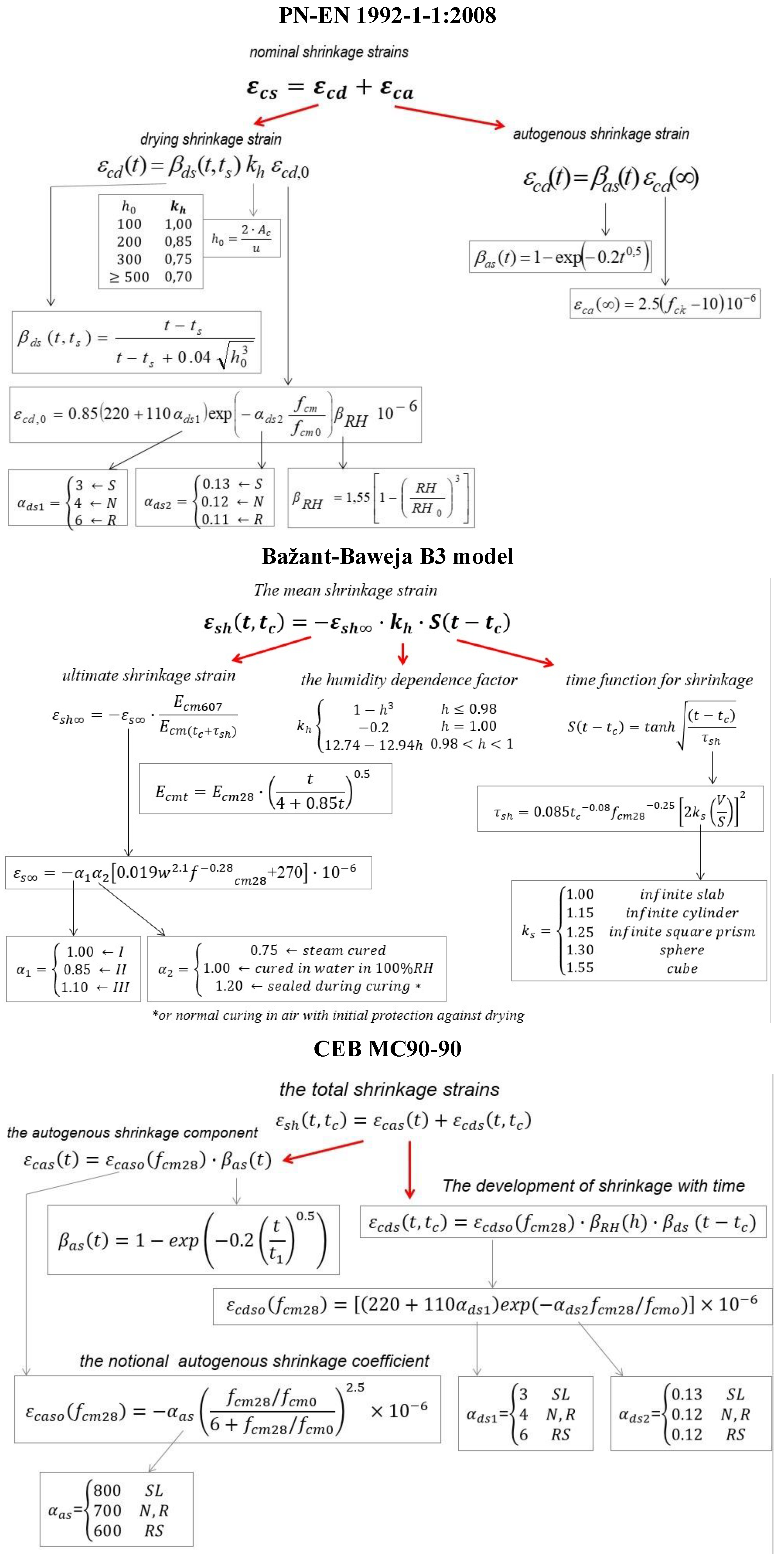
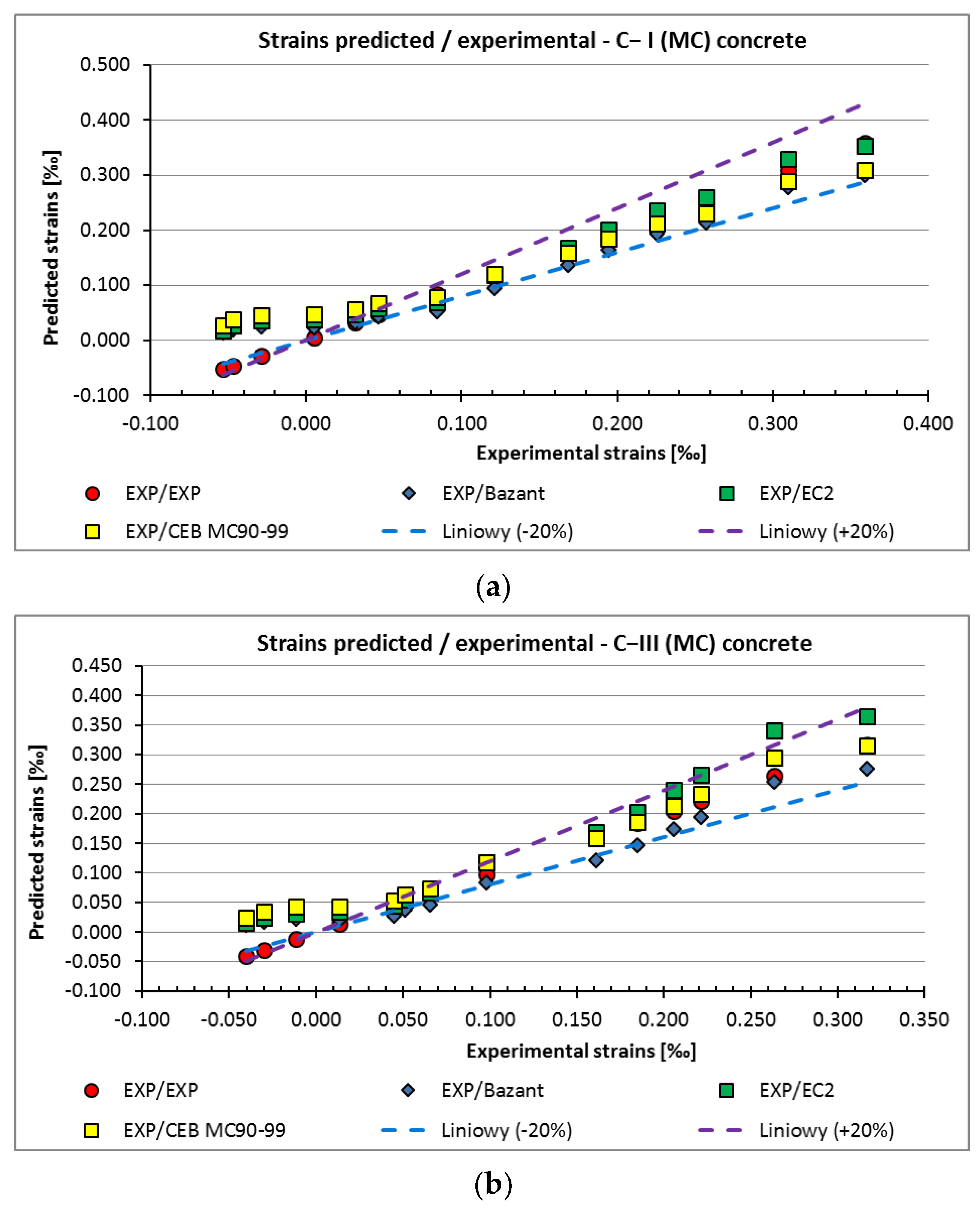
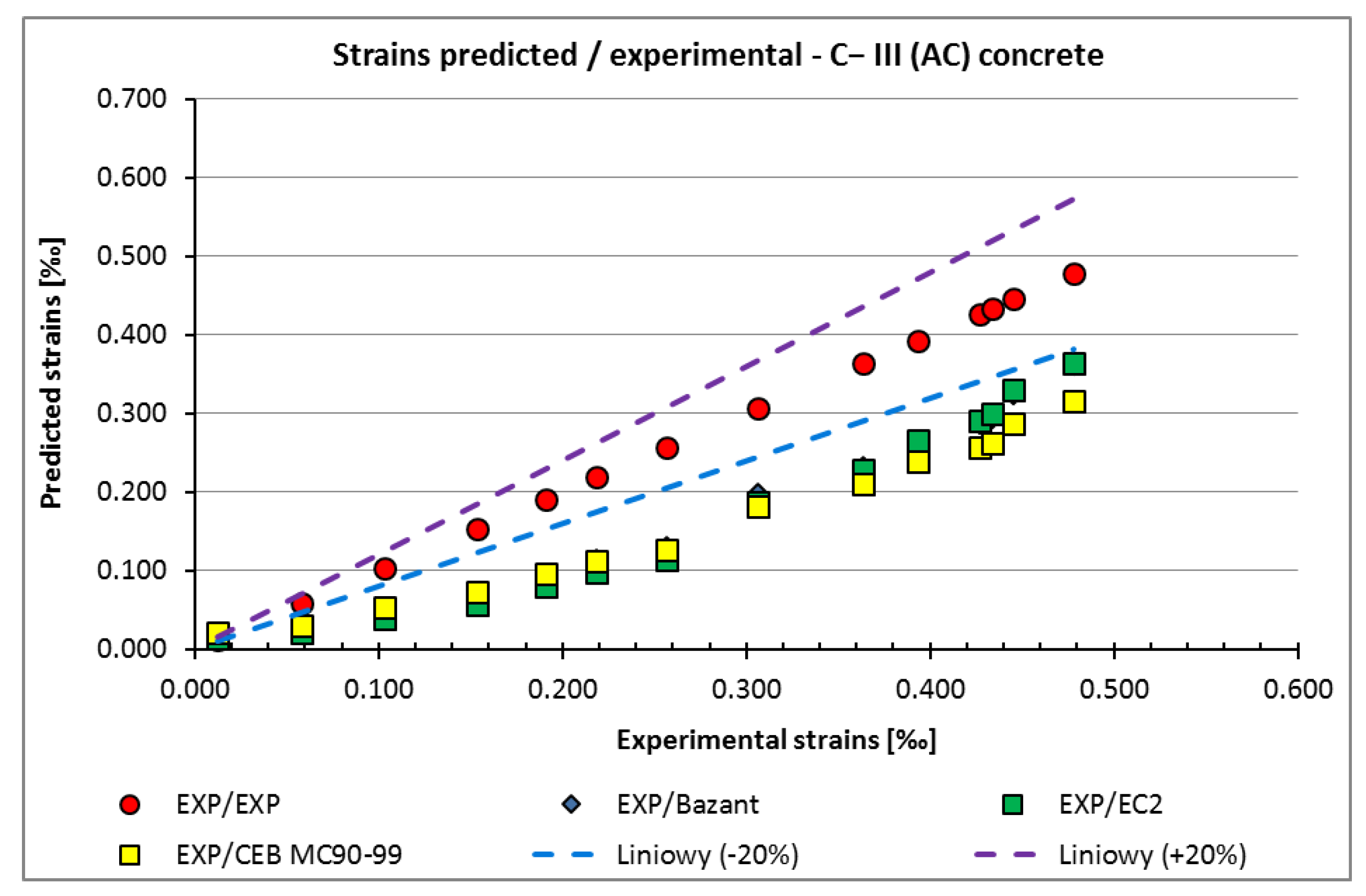



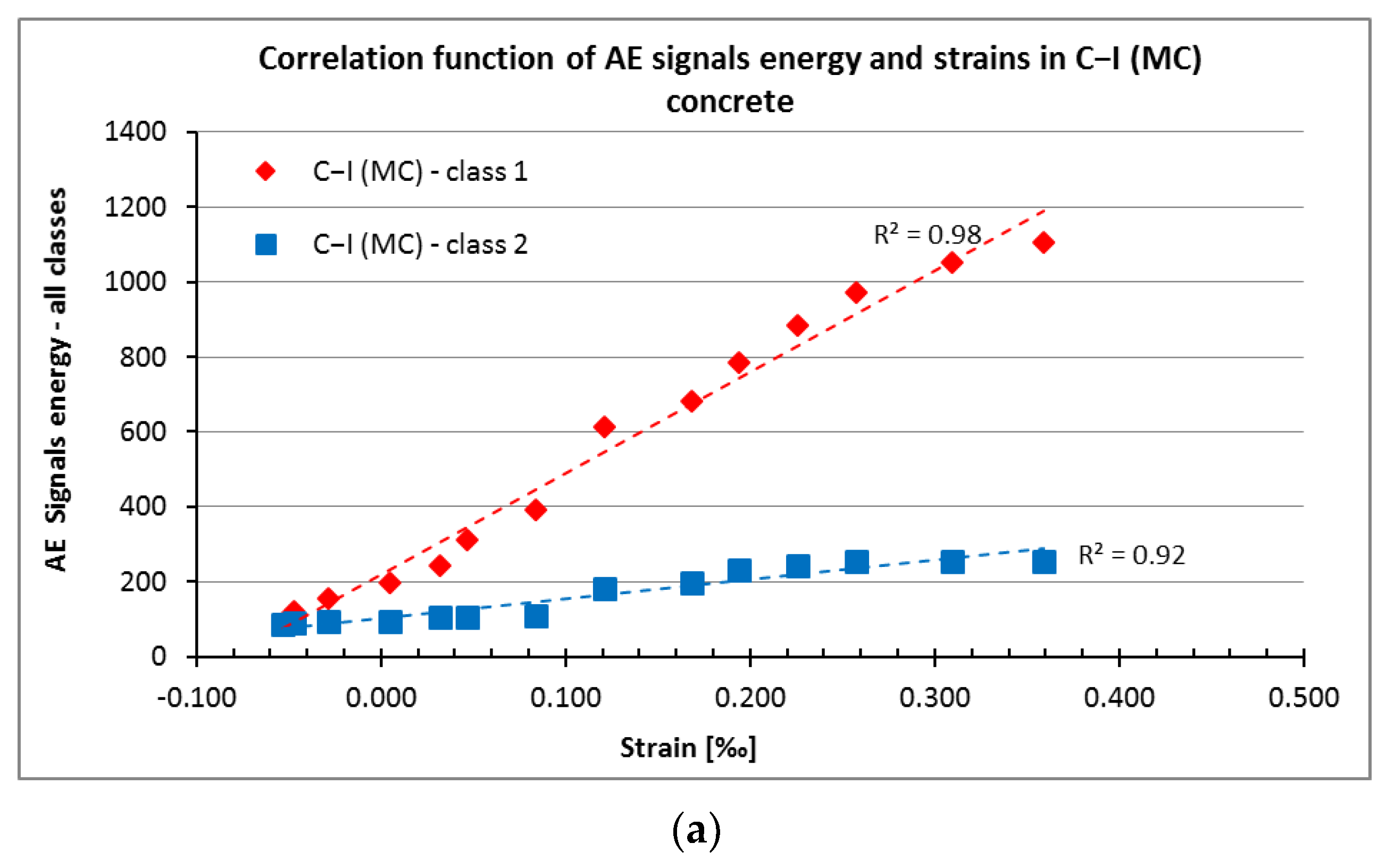
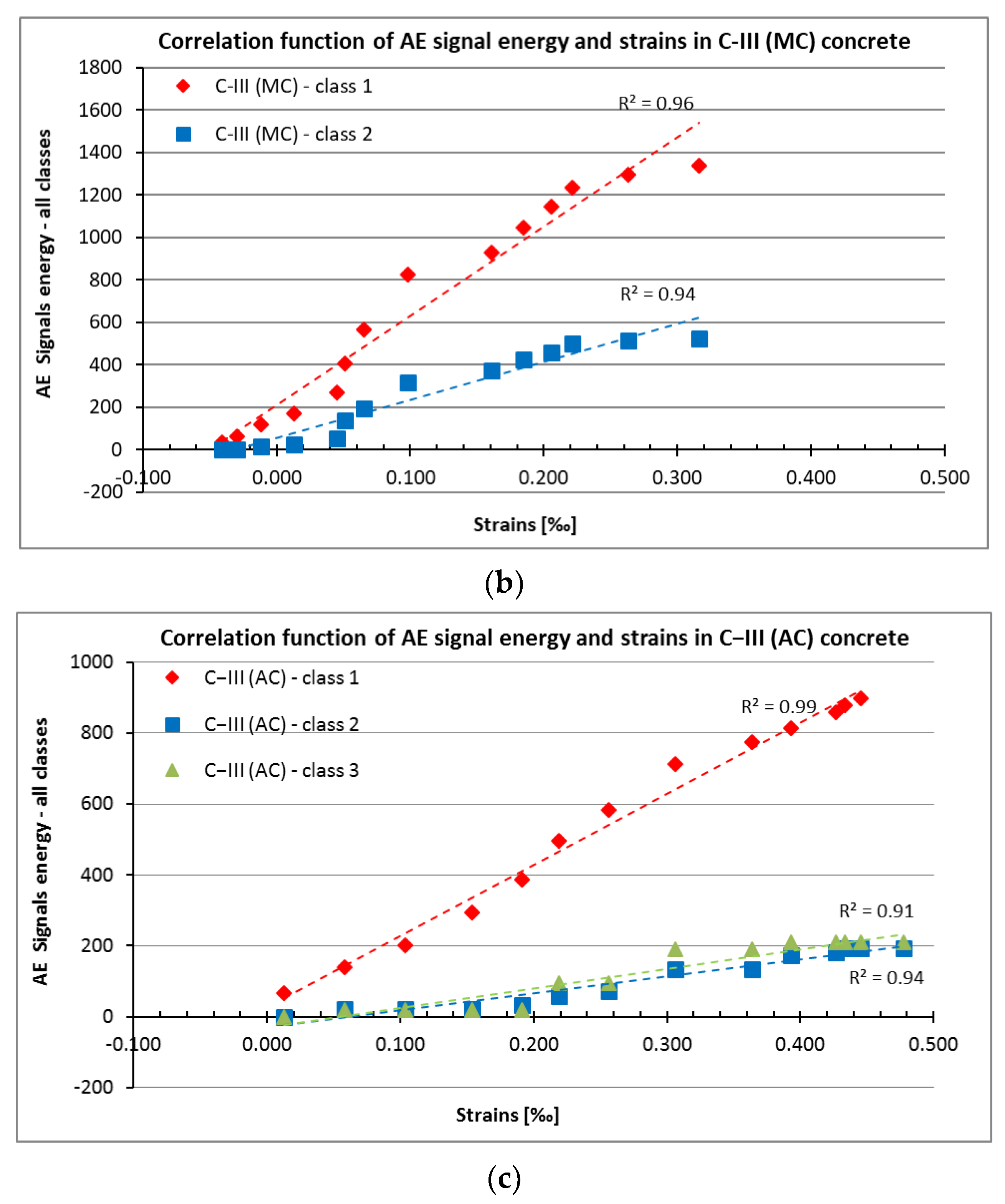

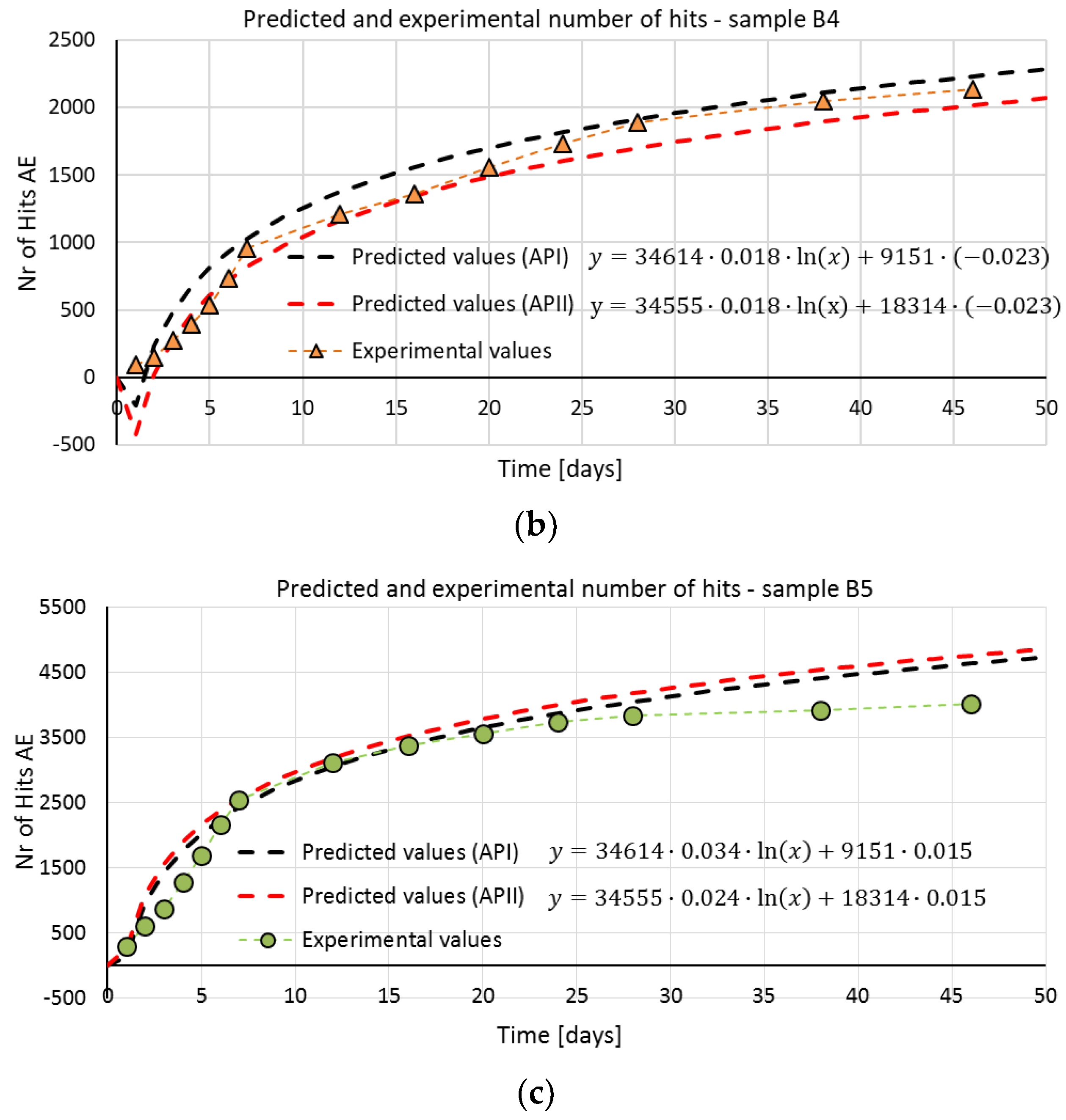
| Symbol | Aggregate | Cement | Hardening Conditions | Temperature Condition |
|---|---|---|---|---|
| C−I (MC) | Basalt | CEM I | 10 days of wet curing | Constant |
| C−III (MC) | Basalt | CEM III | 10 days of wet curing | Constant |
| C−III (AC) | Basalt | CEM III | drying in air | Constant |
| Symbol | Basalt 2–8 | Basalt 8–16 | Sand 0–2 | CEM I | CEM III | Water |
|---|---|---|---|---|---|---|
| C−I (MC) | 581 | 731 | 691 | 360 | x | 180 |
| C−III (MC) | 581 | 731 | 691 | x | 360 | 180 |
| C−III (AC) | 581 | 731 | 691 | x | 360 | 180 |
| Concrete Series | Class 1 | Class 2 | Class 3 |
|---|---|---|---|
| C−I (MC) | y = 8000x + 650 | y = 35x + 7 | |
| C−III (MC) | y = 4200x + 210 | y = 1800x + 55 | |
| C−III (AC) | y = 8800x + 110 | y = 25x − 1.5 | y = 5x − 0.5 |
| Unit Energy | C−I (MC) | C−III (MC) | C−III (AC) |
|---|---|---|---|
| Class 1 | 0.34 | 0.27 | 0.23 |
| Class 2 | 14.05 | 17.57 | 18.99 |
| Class 3 | 113.65 |
| Concrete Series | Class 1 | Class 2 | Class 3 |
|---|---|---|---|
| C−I (MC) | y = 2700x + 220 | y = 515x + 100 | |
| C−III (MC) | y = 15,600x + 785 | y = 100x + 3 | |
| C−III (AC) | y = 2000x + 25 | y = 480x − 30 | y = 555x − 30 |
| Concrete Series | ASK | BSK | AEA | BEA | API | APII | ||
|---|---|---|---|---|---|---|---|---|
| αI | βI | αII | βII | |||||
| C−I (MC) | 0.024 | −0.027 | 909 | −388 | 34.614 | 9151 | 34.555 | 18.314 |
| C−III (MC) | 0.018 | −0.023 | 612 | −270 | ||||
| C−III (AC) | 0.034 | 0.015 | 1129 | 18 | ||||
Publisher’s Note: MDPI stays neutral with regard to jurisdictional claims in published maps and institutional affiliations. |
© 2022 by the authors. Licensee MDPI, Basel, Switzerland. This article is an open access article distributed under the terms and conditions of the Creative Commons Attribution (CC BY) license (https://creativecommons.org/licenses/by/4.0/).
Share and Cite
Bacharz, M.; Bacharz, K.; Trąmpczyński, W. The Correlation between Shrinkage and Acoustic Emission Signals in Early Age Concrete. Materials 2022, 15, 5389. https://doi.org/10.3390/ma15155389
Bacharz M, Bacharz K, Trąmpczyński W. The Correlation between Shrinkage and Acoustic Emission Signals in Early Age Concrete. Materials. 2022; 15(15):5389. https://doi.org/10.3390/ma15155389
Chicago/Turabian StyleBacharz, Magdalena, Kamil Bacharz, and Wiesław Trąmpczyński. 2022. "The Correlation between Shrinkage and Acoustic Emission Signals in Early Age Concrete" Materials 15, no. 15: 5389. https://doi.org/10.3390/ma15155389
APA StyleBacharz, M., Bacharz, K., & Trąmpczyński, W. (2022). The Correlation between Shrinkage and Acoustic Emission Signals in Early Age Concrete. Materials, 15(15), 5389. https://doi.org/10.3390/ma15155389






